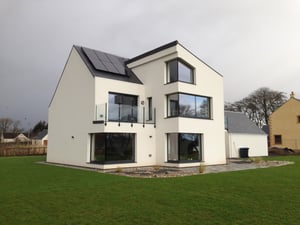The cheapest, easiest way to reduce running costs is to build a smaller house, which would have the added benefit of reducing capital cost as well. But we don’t do that. In fact, we do the opposite. UK homes are some of the biggest in Europe (on square meters per person basis). So, what actually is going on?
In case you missed the previous articles of the Eco Series with Tim, here they are:
 I have been involved in Passivhaus projects, ‘sustainable’ builds where ALL the materials had to be from sustainable sources, high insulation builds, bolting renewable energy systems to otherwise ordinary houses, even a fully demountable house where virtually every component could be taken down and reused in another build.
I have been involved in Passivhaus projects, ‘sustainable’ builds where ALL the materials had to be from sustainable sources, high insulation builds, bolting renewable energy systems to otherwise ordinary houses, even a fully demountable house where virtually every component could be taken down and reused in another build.
And in all these projects one of the criteria, if not the prime criterion, was to reduce running costs. And in every case, it resulted in increased capital cost, and in almost every case an increase in the use of non-sustainable materials.

In the case of Passivhaus, a system which is gaining more traction in recent years, the cost increase is likely to be 15% to 20%, for the benefit of a certificate which will be hung in the downstairs toilet and forgotten forever after. The fabric-first approach will achieve pretty much the same thing at a lower cost increase, but without the benefit of a certificate.
All of these and the likes of triple-glazing and renewable energy are aimed solely at reducing the energy consumption involved in running the house. But only in terms of space heating. In the case of Passivhaus, there is also a ‘primary energy’ requirement which monitors electricity consumption and domestic hot water demands. But for a Passivhaus built using conventional materials and methods, up to 40% of the total energy consumption and CO2 emissions over an 80-year design life will be used in the materials and construction of the house.
SO, WHAT DOES THIS MEAN?
From a purely selfish point of view, reducing energy consumption reduces running costs. But if that was the whole story, as has been said, we would just build a smaller house. So there seems to be something else going on. There is no empirical evidence around this, but anecdotally it would seem to be a mix of a desire for ‘green credentials’ and the MPG argument.
In the same way, as we want bigger, better, faster cars that go further on a gallon of petrol than our old car did, maybe we want bigger, better homes with green credentials – at least those of us interested in Passivhaus do. Is there an argument that we want to be seen to be green, but we are not prepared to give anything up to get it?
And in the summer, I will not need any of that clothing. The same applies to a house. More insulation and better air tightness beyond the optimum level will add to the cost of the house – in financial, energy and CO2 emissions terms – but may have only a marginal impact on comfort and warmth.
The typical design criterion for the heating system in a UK home is -20C – my heating system is working flat-out today, trying to keep up. This design criterion is used because the UK average winter temperature is +70C and temperatures below zero are rare – average is less than 5 days per year.
In Germany, where Passivhaus was developed, the average winter temperature is +30C with extremes of -100C occurring most years. That means that the extra insulation and air tightness has a purpose. It is useful more often and for more of each year and therefore warrants the extra cost – in all terms.

SO, WHAT DO WE DO?
The simple answer is to build to the local conditions. It is clearly nonsense to suggest that a single construction system will be suitable in all climates. What happens is that we get used to building in a certain way, and that way becomes our bible and we cannot conceive that anything else may also be true.
As an example, I was involved in a project building a house on the Greek island of Santorini. It gets hot there, really quite hot. Summer temperature of 400C is usual and the winter temperature rarely falls below 120C and never to zero. The client wanted an energy efficient house, which is why I was involved, and I wanted to build the house with relatively thick, 450mm, concrete block walls with 100mm external insulation.
When this idea was put to the local architect he laughed at the idea. He insisted that the island was hot and houses did not need insulation – I was standing there with sunburnt feet and really did not need telling how hot it was. He could not conceive of the idea that insulation could also help keep the heat out. A compromise was agreed and the house built. The design worked well and the architect conceded that there might be something in this insulation idea.
The notion was that what had worked in the past will work in the future. That introducing new ideas was unnecessary. But what was being proposed to the architect was that adapting known technology to the local conditions would result in a better build. To an extent the same is true of Passivhaus, et al. These systems were developed for climates that have more extreme weather conditions than we enjoy in the UK. Surely it, therefore, follows that these systems need to be adapted to UK conditions, even as those conditions vary from the north-east coast of Scotland to the south-west coast of Wales.

We quite rightly expect continuously rising energy bills and anything that offers to offset that will always be attractive. As a result, the idea of thermally efficient, fabric-first construction is gaining a lot of traction, due in no small part to the influence of the Passivhaus standard. It can be argued that the rarity of weather extremes in the UK does not warrant the investment needed for that particular standard.
It has to be recognised that ‘Passivhaus standard’ items like windows and doors are priced at a level attractive only to the manufacturer. But there are savings to be made in tweaking the standard to suit the UK climate. Which is where fabric-first starts. The purist may argue that driving the energy demand of the house to the lowest possible level is good for the homeowner and good for the planet. But if that drive increases the energy consumption and CO2 emissions needed to build the house then the argument starts to fall down.
We might also argue that ours is a warm, wet maritime climate, (at least for as long as the Gulf Stream keeps working) that renewable energy is now cheap and that not troubling the power station more than we have to is also good for the homeowner and the planet.

Passivhaus, Activhaus, triple-glazing, renewable energy all have their place but there is a balance to be struck. Taking those technologies and adapting them to what is necessary for the homeowner and the local conditions will get true ‘green credentials’, low running cost and the lowest possible build cost. And all it takes is a bit more thought.
We would like to thank Tim for sharing his expertise on our blog. If you would like to learn more about building an Eco home, check out his other articles below!




